
Nicotiana is a genus of herbaceous plants and shrubs in the family Solanaceae, that is indigenous to the Americas, Australia, south west Africa and the South Pacific. Various Nicotiana species, commonly referred to as tobacco plants, are cultivated as ornamental garden plants. N. tabacum is grown worldwide for production of tobacco leaf for cigarettes and other tobacco products.

Nicotiana glauca is a species of wild tobacco known by the common name tree tobacco. Its leaves are attached to the stalk by petioles, and its leaves and stems are neither pubescent nor sticky like Nicotiana tabacum. It resembles Cestrum parqui but differs in the form of leaves and fusion of the outer floral parts. It grows to heights of more than two meters.

Nicotiana sylvestris is a species of flowering plant in the nightshade family Solanaceae, known by the common names woodland tobacco, flowering tobacco, and South American tobacco. It is a perennial plant in the tobacco genus Nicotiana, native to the Andes region in Argentina and Bolivia, in South America.

Nicotiana rustica, commonly known as Aztec tobacco or strong tobacco, is a rainforest plant in the family Solanaceae. It is a very potent variety of tobacco, containing up to nine times more nicotine than common species of Nicotiana such as Nicotiana tabacum. More specifically, N. rustica leaves have a nicotine content as high as 9%, whereas N. tabacum leaves contain about 1 to 3%. The high concentration of nicotine in its leaves makes it useful for producing pesticides, and it has a wide variety of uses specific to cultures around the world. However, N. rustica is no longer cultivated in its native North America, as N. tabacum has replaced it.

Nicotiana alata is a species of tobacco. It is called jasmine tobacco, sweet tobacco, winged tobacco, tanbaku, and Persian tobacco.

Nicotiana benthamiana is a close relative of tobacco and species of Nicotiana indigenous to Australia.
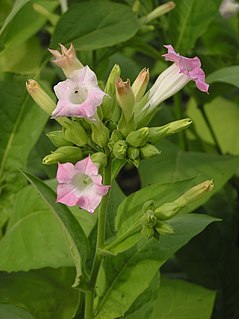
Nicotiana tabacum, or cultivated tobacco, is an annually-grown herbaceous plant. It is found in cultivation, where it is the most commonly grown of all plants in the genus Nicotiana, and its leaves are commercially grown in many countries to be processed into tobacco. It grows to heights between 1 and 2 meters. Research is ongoing into its ancestry among wild Nicotiana species, but it is believed to be a hybrid of Nicotiana sylvestris, Nicotiana tomentosiformis, and possibly Nicotiana otophora.

Anabasine is a pyridine and piperidine alkaloid found in the Tree Tobacco plant, a close relative of the common tobacco plant. It is a structural isomer of, and chemically similar to, nicotine. Its principal (historical) industrial use is as an insecticide. It shouldn't be confused with anabaseine.
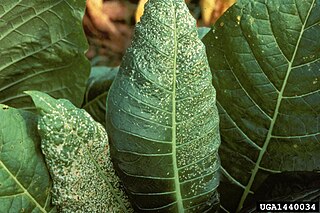
Tobacco etch virus (TEV) is a plant virus in the genus Potyvirus and family Potyviridae. Like other members of the genus Potyvirus, TEV has a monopartite positive-sense, single-stranded RNA genome surrounded by a capsid made from a single viral encoded protein. The virus is a filamentous particle that measures about 730 nm in length. It is transmissible in a non-persistent manner by more than 10 species of aphids including Myzus persicae. It also is easily transmitted by mechanical means but is not known to be transmitted by seeds.
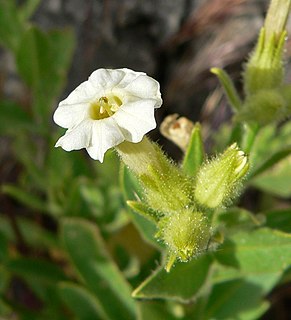
Nicotiana obtusifolia, or desert tobacco, is a plant native to the southwestern United States and Mexico.

This article is a list of tobacco cultivars and varieties.
Nicotiana tomentosiformis is a perennial herbaceous plant. It is a wild species of tobacco native to the Yungas Valley region in the eastern piedmont of the Andes Mountains, primarily in Bolivia.
Nicotiana otophora is a perennial herbaceous plant. It is a wild species of tobacco native to the Andes Mountains of Bolivia and Argentina.

Nicotiana attenuata is a species of wild tobacco known by the common name coyote tobacco. It is native to western North America from British Columbia to Texas and northern Mexico, where it grows in many types of habitat. It is a glandular and sparsely hairy annual herb exceeding a meter in maximum height. The leaf blades may be 10 centimetres (4 in) long, the lower ones oval and the upper narrower in shape, and are borne on petioles. The inflorescence bears several flowers with pinkish or greenish white tubular throats 2 to 3 centimetres long, their bases enclosed in pointed sepals. The flower face has five mostly white lobes. The fruit is a capsule about 1 centimetre long.
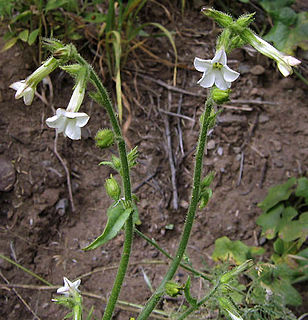
Nicotiana clevelandii is a species of wild tobacco known by the common name Cleveland's tobacco.
The Boston dart or drab cutworm is a moth of the family Noctuidae. It is found from Ontario and Maine to North Carolina, west to Missouri, north to Michigan. It has also been recorded from Florida, California and South Dakota.
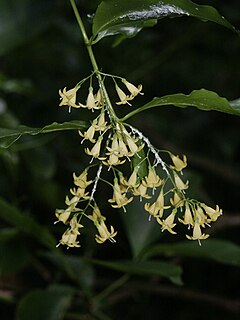
Chiococca alba is a species of flowering plant in the coffee family (Rubiaceae) native to Florida and the extreme southern tip of Texas in the United States, Bermuda, Mexico, Central America, the Caribbean, the Galápagos, and tropical South America. Common names include David's milkberry, West Indian milkberry, cahinca and West Indian snowberry. The specific epithet, alba, means "white" in Latin and refers to the color of its fruits.

Nicotiana glutinosa is a species of tobacco plant that is economically important in tobacco hybrids. N. glutinosa is native to western South America, including Bolivia, Ecuador, and Peru. It is a model organism for the study of Tobacco mosaic virus resistance in tobacco.















